Are Survival Outcomes Different for Young and Old Patients with Oral and Oropharyngeal Squamous Cell Carcinoma? A Systematic Review and Meta-Analysis
Abstract
Simple Summary
Abstract
1. Introduction
2. Materials and Methods
2.1. Data Sources and Search Strategy
- Population: Young adult patients (≤40 years) with OSCC or OPSCC
- Intervention: Surgery with or without chemoradiotherapy
- Comparison: Older adult patients (>40 years) with OSCC or OPSCC
- Outcomes: Overall survival (OS), Disease-free survival (DFS), recurrence, distant metastasis (DM), and second primary (SP)
2.2. Study Selection
2.3. Data Extraction and Quality Assessment
2.4. Data Synthesis and Analysis
3. Results
3.1. Characteristics of Included Studies
3.2. Risk of Bias
3.3. Meta-Analysis
3.3.1. Overall Survival
3.3.2. Disease-Free Survival
3.3.3. Events of Recurrence
3.3.4. Distant Metastasis
3.3.5. Second Primary
3.3.6. Publication Bias
4. Discussion
5. Conclusions
Author Contributions
Funding
Acknowledgments
Conflicts of Interest
Appendix A


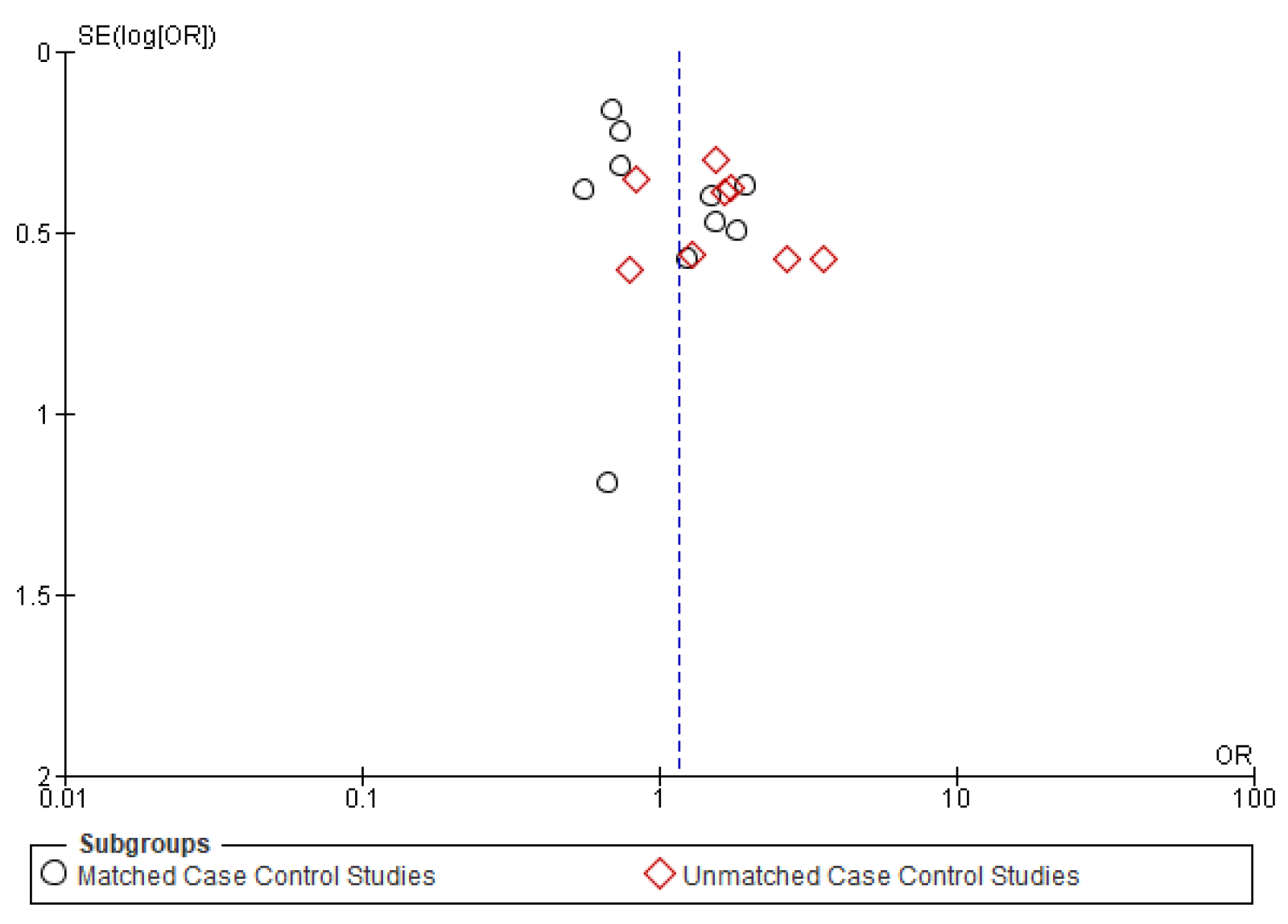
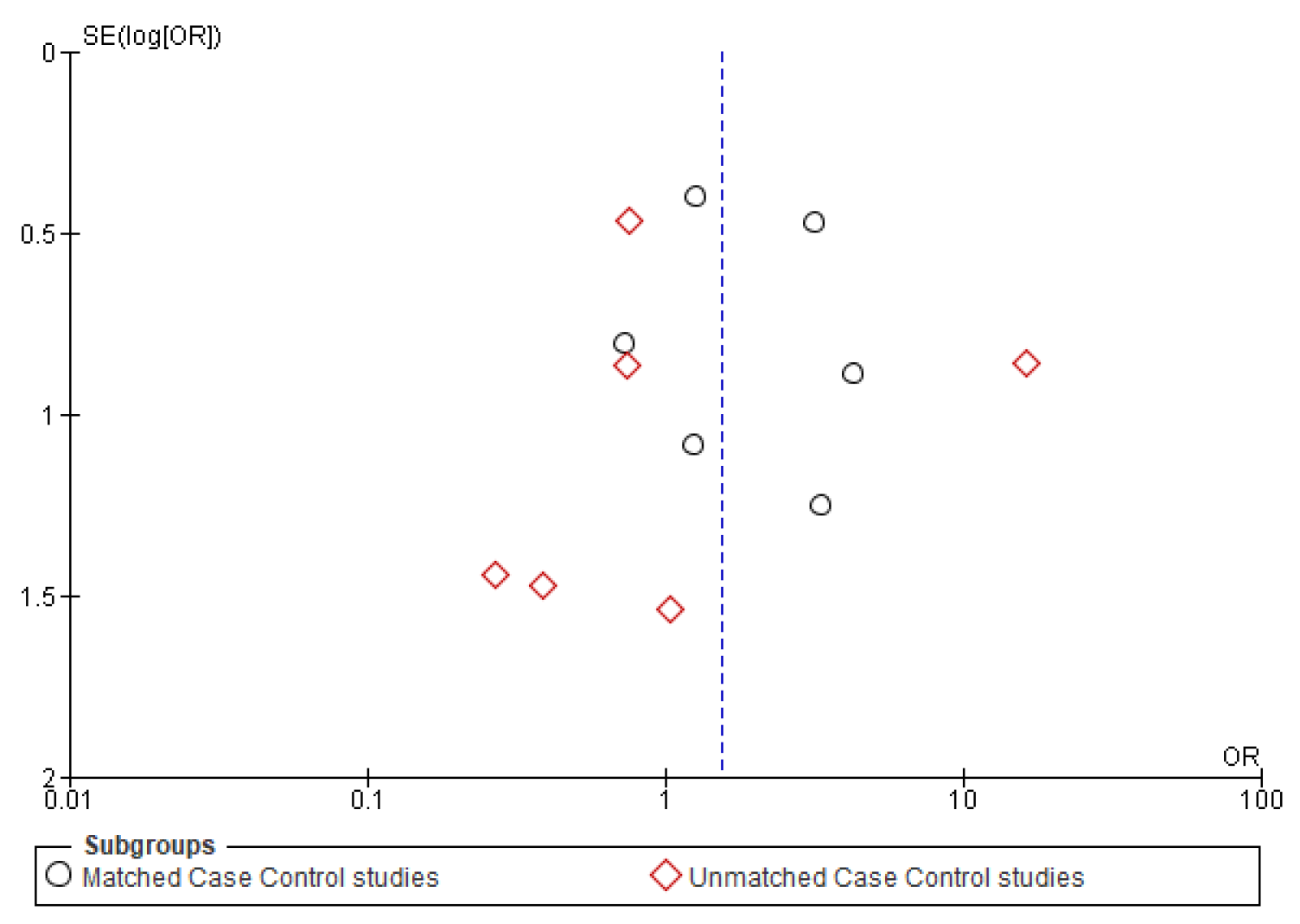

References
- Hussein, A.A.; Helder, M.N.; de Visscher, J.G.; Leemans, C.R.; Braakhuis, B.J.; de Vet, H.C.W.; Forouzanfar, T. Global incidence of oral and oropharynx cancer in patients younger than 45 years versus older patients: A systematic review. Eur. J. Cancer 2017, 82, 115–127. [Google Scholar] [CrossRef] [PubMed]
- Chi, A.C.; Day, T.A.; Neville, B.W. Oral cavity and oropharyngeal squamous cell carcinoma-an update. CA Cancer J. Clin. 2015, 65, 401–421. [Google Scholar] [CrossRef] [PubMed]
- Gopinath, D.; Kunnath Menon, R.; Veettil, S.K.; George Botelho, M.; Johnson, N.W. Periodontal Diseases as Putative Risk Factors for Head and Neck Cancer: Systematic Review and Meta-Analysis. Cancers 2020, 12, 1893. [Google Scholar] [CrossRef]
- Christianto, S.; Li, K.Y.; Huang, T.H.; Su, Y.-X. The Prognostic Value of Human Papilloma Virus Infection in Oral Cavity Squamous Cell Carcinoma: A Meta-Analysis. Laryngoscope 2019, 48, 76. [Google Scholar] [CrossRef]
- Burke, H.B.; Henson, D.E. Criteria for prognostic factors and for an enhanced prognostic system. Cancer 1993, 72, 3131–3135. [Google Scholar] [CrossRef]
- Piccirillo, J.F.; Feinstein, A.R. Clinical symptoms and comorbidity: Significance for the prognostic classification of cancer. Cancer 1996, 77, 834–842. [Google Scholar] [CrossRef]
- Piccirillo, J.F. Importance of comorbidity in head and neck cancer. Laryngoscope 2000, 110, 593–602. [Google Scholar] [CrossRef]
- Xing, Y.; Zhang, J.; Lin, H.; Gold, K.A.; Sturgis, E.M.; Garden, A.S.; Lee, J.J.; William, W.N. Relation between the level of lymph node metastasis and survival in locally advanced head and neck squamous cell carcinoma. Cancer 2016, 122, 534–545. [Google Scholar] [CrossRef]
- Marcus, B.; Arenberg, D.; Lee, J.; Kleer, C.; Chepeha, D.B.; Schmalbach, C.E.; Islam, M.; Paul, S.; Pan, Q.; Hanash, S.; et al. Prognostic factors in oral cavity and oropharyngeal squamous cell carcinoma: The impact of tumor-associated macrophages. Cancer 2004, 101, 2779–2787. [Google Scholar] [CrossRef]
- Howlader, N.; Noone, A.M.; Krapcho, M.; Miller, D.; Brest, A.; Yu, M.; Ruhl, J.; Tatalovich, Z.; Mariotto, A.; Lewis, D.R.; et al. (Eds.) SEER Cancer Statistics Review, 1975–2017; National Cancer Institute: Bethesda, MD, USA. Available online: https://seer.cancer.gov/csr/1975_2017/ (accessed on 10 June 2020).
- McGregor, G.I.; Davis, N.; Robins, R.E. Squamous cell carcinoma of the tongue and lower oral cavity in patients under 40 years of age. Am. J. Surg. 1983, 146, 88–92. [Google Scholar] [CrossRef]
- Carniol, P.J.; Fried, M.P. Head and Neck Carcinoma in Patients under 40 Years of Age. Ann. Otol. Rhinol. Laryngol. 1982, 91, 152–155. [Google Scholar] [CrossRef] [PubMed]
- Amsterdam, J.T.; Strawitz, J.G. Squamous cell carcinoma of the oral cavity in young adults. J. Surg. Oncol. 1982, 19, 65–68. [Google Scholar] [CrossRef] [PubMed]
- Tsai, M.-S.; Lai, C.-H.; Lee, C.-P.; Yang, Y.-H.; Chen, P.-C.; Kang, C.-J.; Chang, G.-H.; Tsai, Y.-T.; Lu, C.-H.; Chien, C.-Y.; et al. Mortality in tongue cancer patients treated by curative surgery: A retrospective cohort study from CGRD. PeerJ 2016, 4, e2794. [Google Scholar] [CrossRef] [PubMed][Green Version]
- Higgins, J.P.T.; Green, S. Cochrane Handbook for Systematic Reviews of Interventions|Cochrane Training. Available online: https://training.cochrane.org/handbook/current (accessed on 10 June 2020).
- Fang, Q.G.; Shi, S.; Liu, F.Y.; Sun, C.F. Tongue squamous cell carcinoma as a possible distinct entity in patients under 40 years old. Oncol. Lett. 2014, 7, 2099–2102. [Google Scholar] [CrossRef] [PubMed]
- Jeon, J.-H.; Kim, M.G.; Park, J.Y.; Lee, J.H.; Kim, M.J.; Myoung, H.; Choi, S.W. Analysis of the outcome of young age tongue squamous cell carcinoma. Maxillofac. Plast. Reconstr. Surg. 2017, 39, 41. [Google Scholar] [CrossRef]
- Mahmood, N.; Muhammad, H.; Ahmed, A.; Jamal, Q.; Saqib, M.; Khan, A. Impact of age at diagnosis on clinicopathological outcomes of oral squamous cell carcinoma patients in Karachi. Pak. J. Med. Sci. 2018, 34, 595–599. [Google Scholar] [CrossRef]
- Sun, Q.; Fang, Q.; Guo, S. A comparison of oral squamous cell carcinoma between young and old patients in a single medical center in China. Int. J. Clin. Exp. Med. 2015, 8, 12418–12423. [Google Scholar]
- Komolmalai, N.; Chuachamsai, S.; Tantiwipawin, S.; Dejsuvan, S.; Buhngamongkol, P.; Wongvised, C.; Chitapanarux, I.; Iamaroon, A. Ten-year analysis of oral cancer focusing on young people in northern Thailand. J. Oral Sci. 2015, 57, 327–334. [Google Scholar] [CrossRef]
- Ur Rahaman, S.; Ahmed Mujib, B. Histopathological correlation of oral squamous cell carcinoma among younger and older patients. J. Oral Maxillofac. Pathol. 2014, 18, 183. [Google Scholar] [CrossRef]
- Kaminagakura, E.; Villa, L.L.; Andreoli, M.A.; Sobrinho, J.S.; Vartanian, J.G.; Soares, F.A.; Nishimoto, I.N.; Rocha, R.; Kowalski, L.P. High-risk human papillomavirus in oral squamous cell carcinoma of young patients. Int. J. Cancer 2012, 130, 1726–1732. [Google Scholar] [CrossRef]
- Kaminagakura, E.; Werneck da Cunha, I.; Soares, F.A.; Nishimoto, I.N.; Kowalski, L.P. CCND1 amplification and protein overexpression in oral squamous cell carcinoma of young patients. Head Neck 2011, 33, 1413–1419. [Google Scholar] [CrossRef] [PubMed]
- Gilroy, J.S.; Morris, C.G.; Amdur, R.J.; Mendenhall, W.M. Impact of young age on prognosis for head and neck cancer: A matched-pair analysis. Head Neck 2005, 27, 269–273. [Google Scholar] [CrossRef] [PubMed]
- Verschuur, H.P.; Irish, J.C.; O’Sullivan, B.; Goh, C.; Gullane, P.J.; Pintilie, M. A Matched Control Study of Treatment Outcome in Young Patients With Squamous Cell Carcinoma of the Head and Neck. Laryngoscope 1999, 109, 249–258. [Google Scholar] [CrossRef] [PubMed]
- Pytynia, K.B.; Grant, J.R.; Etzel, C.J.; Roberts, D.; Wei, Q.; Sturgis, E.M. Matched Analysis of Survival in Patients With Squamous Cell Carcinoma of the Head and Neck Diagnosed Before and After 40 Years of Age. Arch. Otolaryngol. Neck Surg. 2004, 130, 869. [Google Scholar] [CrossRef]
- Siriwardena, B.S.M.S.; Tilakaratne, A.; Amaratunga, E.A.P.D.; Tilakaratne, W.M. Demographic, aetiological and survival differences of oral squamous cell carcinoma in the young and the old in Sri Lanka. Oral Oncol. 2006, 42, 831–836. [Google Scholar] [CrossRef]
- Garavello, W.; Spreafico, R.; Somigliana, E.; Gaini, L.; Pignataro, L.; Gaini, R.M. Prognostic influence of gender in patients with oral tongue cancer. Otolaryngol. Neck Surg. 2008, 138, 768–771. [Google Scholar] [CrossRef]
- Kourelis, K.; Tsue, T.; Girod, D.; Tawfik, O.; Sykes, K.; Shnayder, Y. Negative prognostic factors for head and neck cancer in the young. J. BUON 2013, 18, 459–464. [Google Scholar]
- Xu, Q.; Wang, C.; Li, B.; Kim, K.; Li, J.; Mao, M.; Qin, L.; Li, H.; Huang, X.; Xing, R.; et al. The impact of age on oral squamous cell carcinoma: A longitudinal cohort study of 2782 patients. Oral Dis. 2019, 25, 730–741. [Google Scholar] [CrossRef]
- Lacy, P.D.; Piccirillo, J.F.; Merritt, M.G.; Zequeira, M.R. Head and neck squamous cell carcinoma: Better to be young. Otolaryngol. Neck Surg. 2000, 122, 253–258. [Google Scholar] [CrossRef]
- Ansarin, M.; De Berardinis, R.; Corso, F.; Giugliano, G.; Bruschini, R.; De Benedetto, L.; Zorzi, S.; Maffini, F.; Sovardi, F.; Pigni, C.; et al. Survival Outcomes in Oral Tongue Cancer: A Mono-Institutional Experience Focusing on Age. Front. Oncol. 2021, 11, 1–14. [Google Scholar] [CrossRef]
- Chen, S.; Lin, Z.; Chen, J.; Yang, A.; Zhang, Q.; Xie, C.; Zhang, X.; Yang, Z.; Chen, W.; Song, M. Older age is a risk factor associated with poor prognosis of patients with squamous cell carcinoma of the oral cavity. Eur. Arch. Oto-Rhino-Laryngol. 2020, 277, 2573–2580. [Google Scholar] [CrossRef] [PubMed]
- Hyam, D.; Conway, R.; Sathiyaseelan, Y.; Gebski, V.; Morgan, G.; Walker, D.; Veness, M. Tongue cancer: Do patients younger than 40 do worse? Aust. Dent. J. 2003, 48, 50–54. [Google Scholar] [CrossRef] [PubMed]
- Mukdad, L.; Heineman, T.E.; Alonso, J.; Badran, K.W.; Kuan, E.C.; St. John, M.A. Oral tongue squamous cell carcinoma survival as stratified by age and sex: A surveillance, epidemiology, and end results analysis. Laryngoscope 2019, 129, 2076–2081. [Google Scholar] [CrossRef] [PubMed]
- Oliver, J.R.; Wu, S.P.; Chang, C.M.; Roden, D.F.; Wang, B.; Hu, K.S.; Schreiber, D.; Givi, B. Survival of oral tongue squamous cell carcinoma in young adults. Head Neck 2019, 41, 2960–2968. [Google Scholar] [CrossRef]
- Veness, M.J.; Morgan, G.J.; Sathiyaseelan, Y.; Gebski, V. Anterior tongue cancer: Age is not a predictor of outcome and should not alter treatment. ANZ J. Surg. 2003, 73, 899–904. [Google Scholar] [CrossRef]
- Liao, C.-T.; Wang, H.-M.; Hsieh, L.-L.; Chang, J.T.-C.; Ng, S.-H.; Hsueh, C.; Lee, L.-Y.; Lin, C.H.; Chen, I.-H.; Kang, C.-J.; et al. Higher distant failure in young age tongue cancer patients. Oral Oncol. 2006, 42, 718–725. [Google Scholar] [CrossRef]
- Friedlander, P.L.; Schantz, S.P.; Shaha, A.R.; Yu, G.; Shah, J.P. Squamous cell carcinoma of the tongue in young patients: A matched-pair analysis. Head Neck 1998, 20, 363–368. [Google Scholar] [CrossRef]
- Galvis, M.; Jardim, J.; Kaminagakura, E.; Santos-Silva, A.R.; Fonseca, F.; Almeida, O.; Lopes, M.; Pinto, C.; Kowalski, L.P. Expression of cell cycle proteins according to HPV status in oral squamous cell carcinoma affecting young patients: A pilot study. Oral Surg. Oral Med. Oral Pathol. Oral Radiol. 2018, 125, 317–325. [Google Scholar] [CrossRef]
- Mohideen, K.; Krithika, C.; Jeddy, N.; Balakrishnan, T.; Bharathi, R.; Sankari, S. A meta-analysis of oral squamous cell carcinoma in young adults with a comparison to the older group patients (2014–2019). Contemp. Clin. Dent. 2021, 12, 213–221. [Google Scholar] [CrossRef]
- Marchiano, E.; Argirion, I.; Vandenberg, T.; Bhangale, A.D.; Birkeland, A.C.; Prince, M.E.P.; Bradford, C.R.; McHugh, J.B.; Chepeha, D.B.; Sartor, M.A.; et al. Defining the Young Patient with Oral Cavity Cancer: Phenotypic and Genotypic Analysis. SSRN Electron. J. 2021, 100, 1354–1355. [Google Scholar] [CrossRef]
- Sarode, G.; Maniyar, N.; Sarode, S.C.; Choudhary, N.; Mehta, V.; Gopalakrishnan, D.; Yerwadekar, S.; Joshi, S.; Pendyala, G.; Patil, S. Oral Cancer in Young vs Old Individuals: A Systematic Review. J. Contemp. Dent. Pract. 2021, 22, 435–451. [Google Scholar] [CrossRef] [PubMed]
- Lee, D.S.; Ramirez, R.J.; Lee, J.J.; Valenzuela, C.V.; Zevallos, J.P.; Mazul, A.L.; Puram, S.V.; Doering, M.M.; Pipkorn, P.; Jackson, R.S. Survival of Young Versus Old Patients With Oral Cavity Squamous Cell Carcinoma: A Meta-Analysis. Laryngoscope 2021, 131, 1310–1319. [Google Scholar] [CrossRef] [PubMed]
- Gopinath, D.; Kunnath Menon, R. Unravelling the molecular signatures in HNSCC: Is the homogenous paradigm becoming obsolete? Oral Oncol. 2018, 82, 195. [Google Scholar] [CrossRef] [PubMed]
- Tang, P.A.; Bentzen, S.M.; Chen, E.X.; Siu, L.L. Surrogate End Points for Median Overall Survival in Metastatic Colorectal Cancer: Literature-Based Analysis From 39 Randomized Controlled Trials of First-Line Chemotherapy. J. Clin. Oncol. 2007, 25, 4562–4568. [Google Scholar] [CrossRef]
- Buyse, M.; Burzykowski, T.; Carroll, K.; Michiels, S.; Sargent, D.J.; Miller, L.L.; Elfring, G.L.; Pignon, J.-P.; Piedbois, P. Progression-Free Survival Is a Surrogate for Survival in Advanced Colorectal Cancer. J. Clin. Oncol. 2007, 25, 5218–5224. [Google Scholar] [CrossRef]
- Nie, R.-C.; Zou, X.-B.; Yuan, S.-Q.; Chen, Y.-B.; Chen, S.; Chen, Y.-M.; Chen, G.-M.; Chen, X.-J.; Luo, T.-Q.; Li, S.-M.; et al. Disease-free survival as a surrogate endpoint for overall survival in adjuvant trials of pancreatic cancer: A meta-analysis of 20 randomized controlled trials. BMC Cancer 2020, 20, 421. [Google Scholar] [CrossRef]
- Santos-Silva, A.R.; Ribeiro, A.C.P.; Soubhia, A.M.P.; Miyahara, G.I.; Carlos, R.; Speight, P.M.; Hunter, K.D.; Torres-Rendon, A.; Vargas, P.A.; Lopes, M.A. High incidences of DNA ploidy abnormalities in tongue squamous cell carcinoma of young patients: An international collaborative study. Histopathology 2011, 58, 1127–1135. [Google Scholar] [CrossRef]
- Tremblay, S.; Pintor dos Reis, P.; Bradley, G.; Galloni, N.N.; Perez-Ordonez, B.; Freeman, J.; Brown, D.; Gilbert, R.; Gullane, P.; Irish, J.; et al. Young Patients With Oral Squamous Cell Carcinoma. Arch. Otolaryngol. Neck Surg. 2006, 132, 958. [Google Scholar] [CrossRef]
- O’Regan, E.M.; Toner, M.E.; Smyth, P.C.; Finn, S.P.; Timon, C.; Cahill, S.; Flavin, R.; O’Leary, J.J.; Sheils, O. Distinct array comparative genomic hybridization profiles in oral squamous cell carcinoma occurring in young patients. Head Neck 2006, 28, 330–338. [Google Scholar] [CrossRef]
- dos Santos Costa, S.F.; Brennan, P.A.; Gomez, R.S.; Fregnani, E.R.; Santos-Silva, A.R.; Martins, M.D.; de Castro-Junior, G.; Rahimi, S.; Fonseca, F.P. Molecular basis of oral squamous cell carcinoma in young patients: Is it any different from older patients? J. Oral Pathol. Med. 2018, 47, 541–546. [Google Scholar] [CrossRef]
- Ho, A.S.; Kraus, D.H.; Ganly, I.; Lee, N.Y.; Shah, J.P.; Morris, L.G.T. Decision making in the management of recurrent head and neck cancer. Head Neck 2014, 36, 144–151. [Google Scholar] [CrossRef] [PubMed]
- Taslim, S.J.; Leemans, C.R.; van der Waal, I.; Karagozoglu, K.H. Follow-up of oral cancer patients: Three uneventful years may be enough. Oral Surg. Oral Med. Oral Pathol. Oral Radiol. 2016, 122, 434–439. [Google Scholar] [CrossRef] [PubMed]
- Rennemo, E.; Zätterström, U.; Boysen, M. Impact of Second Primary Tumors on Survival in Head and Neck Cancer: An Analysis of 2063 Cases. Laryngoscope 2008, 118, 1350–1356. [Google Scholar] [CrossRef] [PubMed]
- Liao, L.-J.; Chou, H.-W.; Wang, C.-T.; Chung, C.-S.; Lai, M.-S. The Impact of Second Primary Malignancies on Head and Neck Cancer Survivors: A Nationwide Cohort Study. PLoS ONE 2013, 8, e62116. [Google Scholar] [CrossRef]
- Lee, D.H.; Roh, J.-L.; Baek, S.; Jung, J.H.; Choi, S.-H.; Nam, S.Y.; Kim, S.Y. Second Cancer Incidence, Risk Factor, and Specific Mortality in Head and Neck Squamous Cell Carcinoma. Otolaryngol. Neck Surg. 2013, 149, 579–586. [Google Scholar] [CrossRef]
- Iwatsubo, T.; Ishihara, R.; Morishima, T.; Maekawa, A.; Nakagawa, K.; Arao, M.; Ohmori, M.; Iwagami, H.; Matsuno, K.; Inoue, S.; et al. Impact of age at diagnosis of head and neck cancer on incidence of metachronous cancer. BMC Cancer 2019, 19, 3. [Google Scholar] [CrossRef]
- Sharma, S.; Satyanarayana, L.; Asthana, S.; Shivalingesh, K.K.; Goutham, B.S.; Ramachandra, S. Oral cancer statistics in India on the basis of first report of 29 population-based cancer registries. J. Oral Maxillofac. Pathol. 2018, 22, 18–26. [Google Scholar] [CrossRef]
- Lin, N.-C.; Hsu, J.-T.; Tsai, K.-Y. Difference between Female and Male Patients with Oral Squamous Cell Carcinoma: A Single-Center Retrospective Study in Taiwan. Int. J. Environ. Res. Public Health 2020, 17, 3978. [Google Scholar] [CrossRef]
- Venables, C.W.; Craft, I.L. Carcinoma of the tongue in early adult life. Br. J. Cancer 1967, 21, 645–650. [Google Scholar] [CrossRef]
- Kuriakose, M.; Sankaranarayanan, M.; Nair, M.K.; Cherian, T.; Sugar, A.W.; Scully, C.; Prime, S.S. Comparison of oral squamous cell carcinoma in younger and older patients in India. Eur. J. Cancer Part B Oral Oncol. 1992, 28, 113–120. [Google Scholar] [CrossRef]
- Schantz, S.P.; Yu, G.-P. Head and Neck Cancer Incidence Trends in Young Americans, 1973–1997, With a Special Analysis for Tongue Cancer. Arch. Otolaryngol. Neck Surg. 2002, 128, 268. [Google Scholar] [CrossRef]
- Llewellyn, C.; Johnson, N.; Warnakulasuriya, K.A.A. Risk factors for squamous cell carcinoma of the oral cavity in young people—A comprehensive literature review. Oral Oncol. 2001, 37, 401–418. [Google Scholar] [CrossRef]
- Troeltzsch, M.; Knösel, T.; Eichinger, C.; Probst, F.; Troeltzsch, M.; Woodlock, T.; Mast, G.; Ehrenfeld, M.; Otto, S. Clinicopathologic Features of Oral Squamous Cell Carcinoma: Do They Vary in Different Age Groups? J. Oral Maxillofac. Surg. 2014, 72, 1291–1300. [Google Scholar] [CrossRef] [PubMed]
- Sasaki, T.; Moles, D.R.; Imai, Y.; Speight, P.M. Clinico-pathological features of squamous cell carcinoma of the oral cavity in patients <40 years of age. J. Oral Pathol. Med. 2005, 34, 129–133. [Google Scholar] [CrossRef] [PubMed]
- Pitman, K.T.; Johnson, J.T.; Wagner, R.L.; Myers, E.N. Cancer of the tongue in patients less than forty. Head Neck 2000, 22, 297–302. [Google Scholar] [CrossRef]
- Bell, R.B.; Kademani, D.; Homer, L.; Dierks, E.J.; Potter, B.E. Tongue Cancer: Is There a Difference in Survival Compared With Other Subsites in the Oral Cavity? J. Oral Maxillofac. Surg. 2007, 65, 229–236. [Google Scholar] [CrossRef]
- Weckx, A.; Riekert, M.; Grandoch, A.; Schick, V.; Zöller, J.E.; Kreppel, M. Time to recurrence and patient survival in recurrent oral squamous cell carcinoma. Oral Oncol. 2019, 94, 8–13. [Google Scholar] [CrossRef]
- Agarwal, J.; Krishnatry, R.; Gupta, T.; Murthy, V.; Ghosh-Laskar, S.; Budrukkar, A.; Chaturvedi, P.; Nair, S.; Nair, D.; Kumar, P.; et al. Factors predicting ‘time to distant metastasis’ in radically treated head and neck cancer. Indian J. Cancer 2014, 51, 231. [Google Scholar] [CrossRef]
- Chen, P.-T.; Kuan, F.-C.; Huang, C.-E.; Chen, M.-F.; Huang, S.-H.; Chen, M.-C.; Lee, K.-D. Incidence and Patterns of Second Primary Malignancies Following Oral Cavity Cancers in a Prevalent Area of Betel-nut Chewing: A Population-based Cohort of 26,166 Patients in Taiwan. Jpn. J. Clin. Oncol. 2011, 41, 1336–1343. [Google Scholar] [CrossRef]


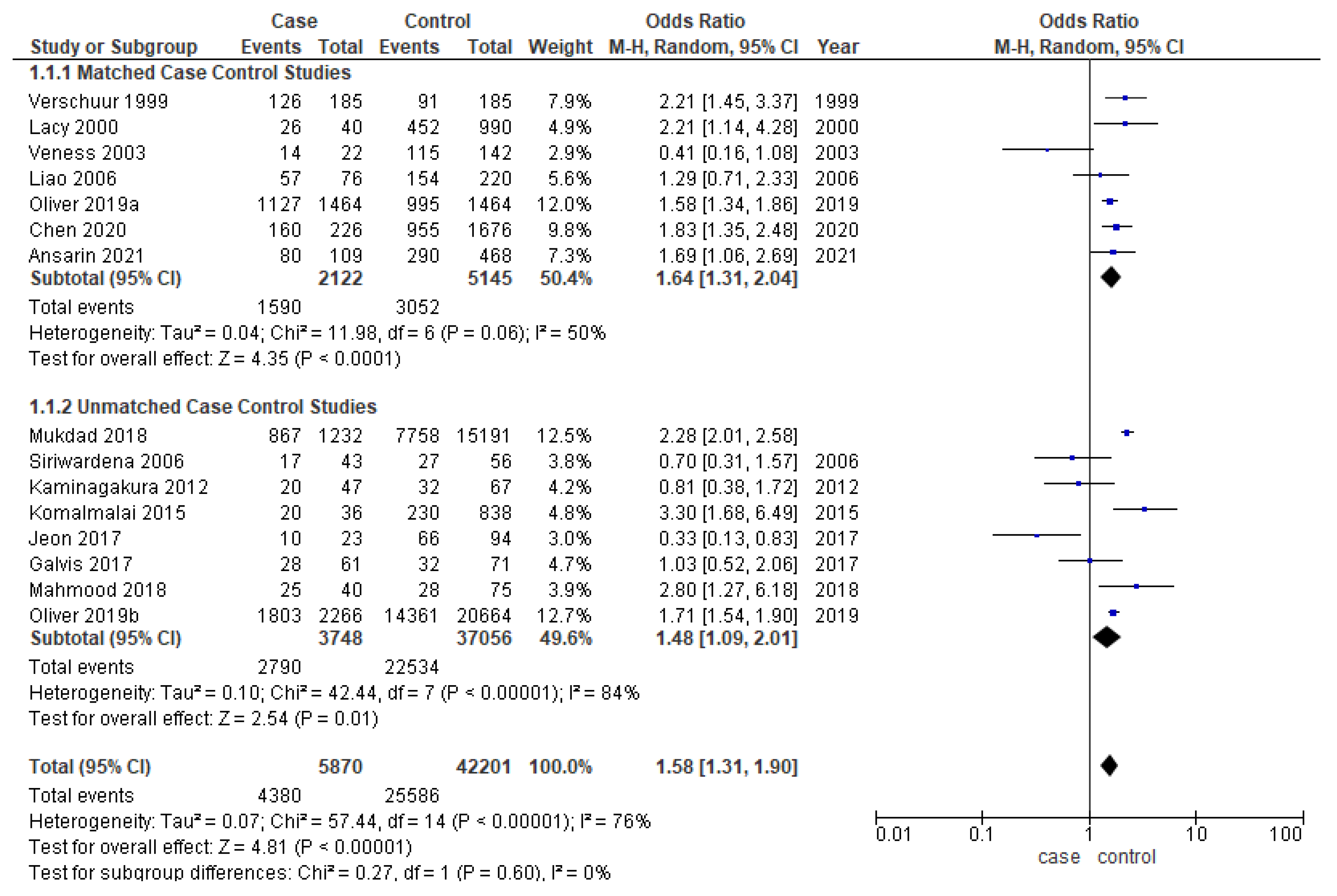

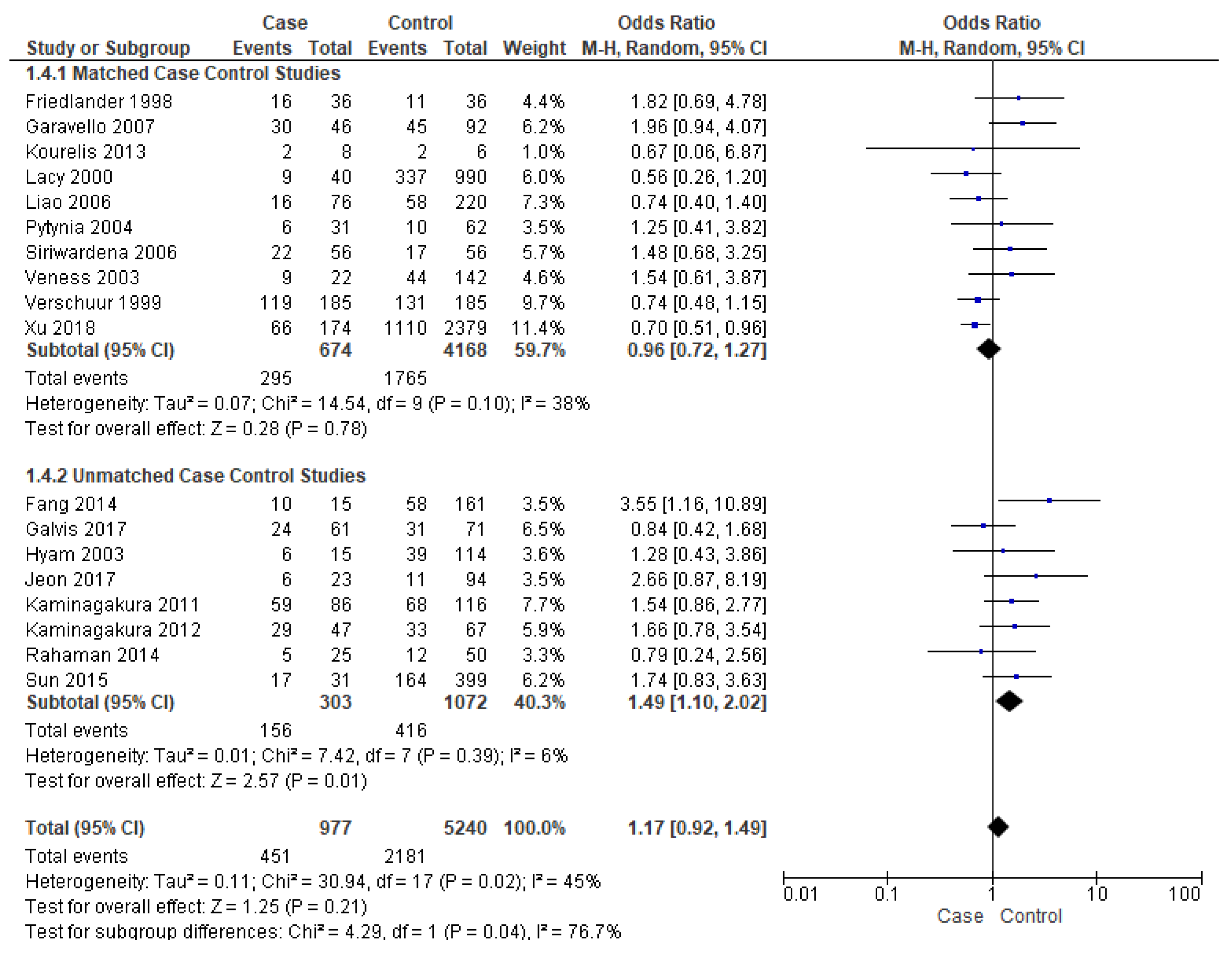
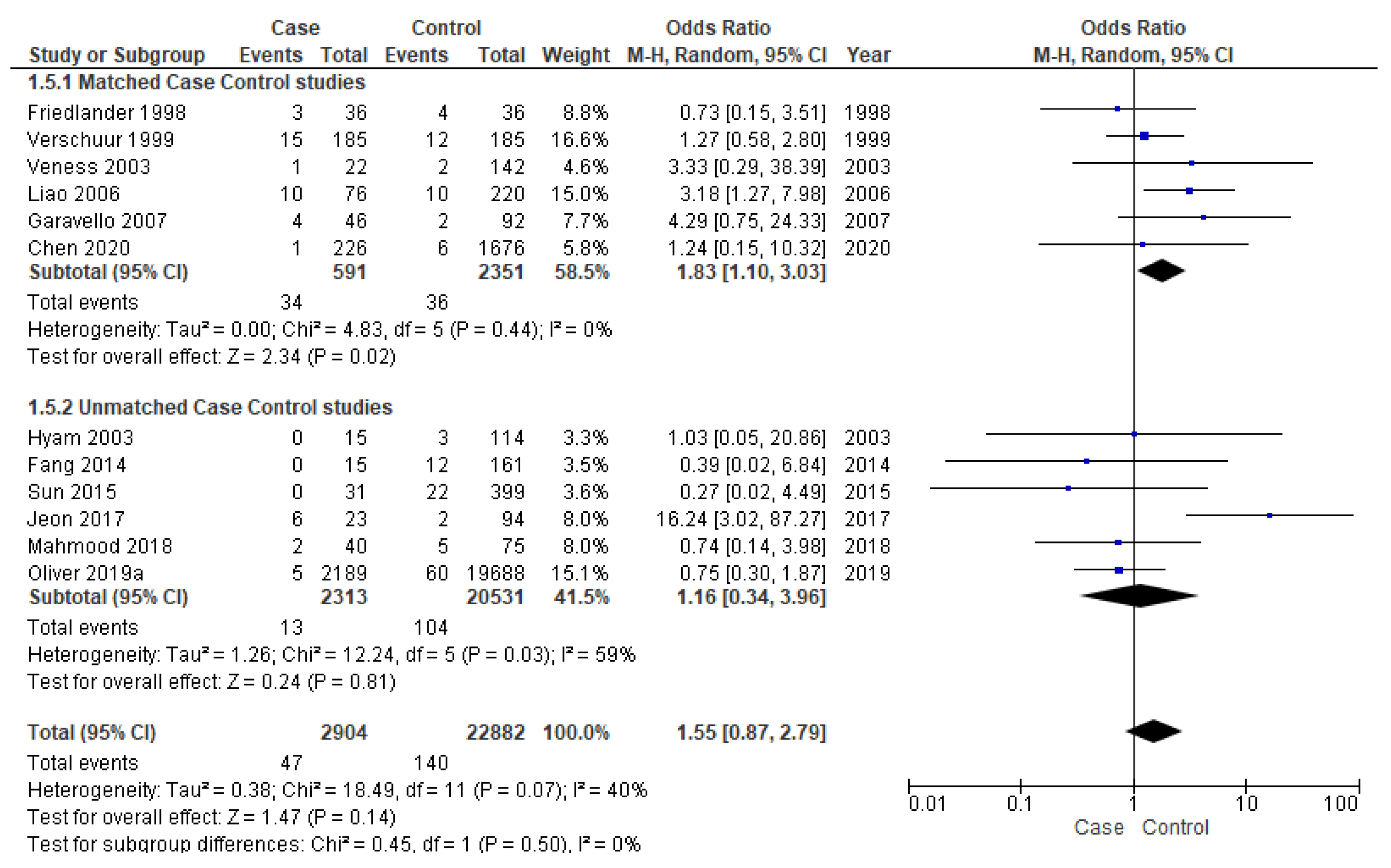

| Author/Year | M:F | Site | Staging | Grading | ||||||||||||
|---|---|---|---|---|---|---|---|---|---|---|---|---|---|---|---|---|
| Case | Control | Case | Control | Case (Early) | Case (Late) | NR | Control (Early) | Control (Late) | NR | Case (High) | Case (Low) | NR | Control (High) | Control (Low) | NR | |
| Oliver et al. (2019) [36] | 1211: 1055 | 12,502: 8162 | Tongue (E) | Tongue (E) | 1225 | 515 | 526 | 11,529 | 4342 | 4793 | 1725 | 362 | 179 | 15,659 | 2956 | 2049 |
| Mahmood et al. (2018) [18] | 33:7 | 49:26 | Mixed | Mixed | 2 | 38 | 0 | 8 | 67 | 0 | 29 | 11 | 0 | 68 | 7 | 0 |
| Galvis et al. (2018) [40] | 45:16 | 56:15 | Tongue (P) | Tongue (P) | 16 | 45 | 0 | 14 | 57 | 0 | 53 | 36 | 2 | 62 | 4 | 5 |
| Jeon et al. (2017) [17] | 15:8 | 51:43 | Tongue (E) | Tongue (E) | 9 | 14 | 0 | 47 | 37 | 0 | 16 | 6 | 1 | 86 | 5 | 3 |
| Sun et al. (2017) [17] | 19:12 | 277:122 | Tongue (P) | Tongue (P) | 22 | 12 | 0 | 234 | 165 | 0 | 22 | 9 | 0 | 308 | 91 | 0 |
| Komolmalai et al. (2015) [20] | 23:13 | 494:344 | Tongue (P) | Tongue (P) | 14 | 13 | 0 | 252 | 411 | 175 | 29 | 5 | 2 | 722 | 62 | 51 |
| Rahaman et al. (2014) [21] | NR | NR | DNA | DNA | NR | NR | 0 | NR | NR | 0 | 19 | 6 | 0 | 37 | 13 | 0 |
| Fang et al. (2014) [16] | 6:9 | 113:48 | Tongue (E) | Tongue (E) | 12 | 6 | 0 | 112 | 49 | 0 | 10 | 5 | 0 | 121 | 40 | 0 |
| Kaminagakura et al. (2011) [23] | 30:17 | 51:16 | Tongue (P) | Tongue (P) | 9 | 38 | 0 | 17 | 50 | 0 | 40 | 7 | 0 | 65 | 2 | 0 |
| Kaminagakura et al. (2012) [22] | 65:25 | 99:26 | Tongue (P) | Tongue (P) | 14 | 76 | 0 | 21 | 104 | 0 | 63 | 27 | 0 | 109 | 4 | 0 |
| Gilroy et al. (2005) [24] | NR | NR | Mixed | Mixed | 3 | 27 | 0 | 3 | 27 | 0 | 19 | 11 | 0 | 17 | 13 | 0 |
| Friedlander et al. (1998) [39] | 20:16 | NR | Tongue (E) | Tongue (E) | 29 | 7 | 0 | 29 | 7 | 0 | NR | NR | NR | NR | NR | NR |
| Verschuur et al. (1999) [25] | 1.68:1 | 3.28:1 | Mixed | Mixed | 93 | 91 | 0 | 94 | 90 | 0 | NR | NR | NR | NR | NR | NR |
| Pytynia et al. (2004) [26] | 10:21:00 | 20:42 | Mixed | Mixed | 10 | 21 | 0 | 20 | 42 | 0 | NR | NR | NR | NR | NR | NR |
| Siriwardena et al. (2006) [27] | 4:01:00 | 3.7:1 | Mixed | Mixed | NR | NR | 0 | NR | NR | 0 | NR | NR | NR | NR | NR | NR |
| Garavello et al. (2008) [28] | 31:15:00 | 62:30 | Tongue (E) | Tongue (E) | 34 | 12 | 0 | 68 | 24 | 0 | 36 | 10 | 0 | 70 | 22 | 0 |
| Lacy et al. (2000) [31] | 29:11:00 | 710:280 | Mixed | Mixed | 18 | 22 | 0 | 438 | 552 | 0 | 36 | 4 | 0 | 881 | 109 | 0 |
| Kourelis et al. (2013) [29] | NR | NR | Tongue (P) | Tongue (P) | 46 | 23 | 0 | 46 | 23 | 0 | 44 | 25 | 0 | 44 | 25 | 0 |
| Hyam et al. (2003) [34] | 9:06:00 | 75:29 | Tongue (E) | Tongue (E) | 10 | 5 | 0 | 71 | 43 | 0 | 5 | 10 | 0 | 76 | 35 | 0 |
| Mukdad et al. (2019) [35] | 706:526 | 8895:6296 | Tongue (E) | Tongue (E) | 316 | 191 | 0 | 4215 | 2244 | 0 | 896 | 203 | 0 | 10,946 | 2186 | 0 |
| Liao et al. (2006) [38] | 71:5 | 194:26 | Tongue (E) | Tongue (E) | 37 | 39 | 0 | 117 | 103 | 0 | 73 | 3 | 0 | 202 | 18 | 0 |
| Veness et al. (2003) [37] | 13:9 | 93:49 | Tongue (E) | Tongue (E) | 14 | 8 | 0 | 91 | 51 | 0 | 12 | 6 | 4 | 110 | 23 | 7 |
| Xu et al. (2019) [30] | 109:65 | 1330:1049 | Tongue (P) | Tongue (P) | 91 | 52 | 0 | 1304 | 798 | 0 | 148 | 12 | 0 | 399 | 17 | 0 |
| Ansari et al. (2021) [32] | 66:43 | 281:187 | Tongue (E) | Tongue (E) | 40 | 69 | 0 | 184 | 284 | 0 | 88 | 19 | 0 | 365 | 85 | 0 |
| Chen et al. (2020) [33] | 135:91 | 1156:520 | Tongue (P) | Tongue (P) | 117 | 93 | 16 | 847 | 730 | 99 | NR | NR | NR | NR | NR | NR |
| Total | 2181 | 1417 | 542 | 19,761 | 10,300 | 5067 | 3363 | 777 | 188 | 30,347 | 5717 | 2115 | ||||
| Authors | Follow Up (Months) | Number of Events | ||||||||||
|---|---|---|---|---|---|---|---|---|---|---|---|---|
| 3–5 Year Overall Survival | Disease-Free Survival | Recurrence | Distant Metastasis | Second Primary | ||||||||
| Case | Control | Case | Control | Case | Control | Case | Control | Case | Control | Case | Control | |
| Oliver et al., 2019 [36] | 6 | 45 | 1127 | 995 | 5 | 60 | ||||||
| Oliver et al., 2019 [36] | 45 | 45 | ||||||||||
| Mahmood et al., 2018 [18] | 50 | 55 | 25 | 28 | 2 | 5 | ||||||
| Galvis et al., 2018 [40] | 60 | 60 | 28 | 32 | 17 | 31 | 24 | 31 | ||||
| Jeon et al., 2017 [17] | 20 | 20 | 10 | 66 | 9 | 69 | 6 | 11 | 6 | 2 | ||
| Sun et al., 2015 [19] | 96 | 96 | 17 | 164 | 0 | 22 | ||||||
| Komolmalai et al., 2015 [20] | 60 | 60 | 20 | 230 | ||||||||
| Rahaman et al., 2014 [21] | 60 | 60 | 5 | 12 | ||||||||
| Fang et al., 2014 [16] | 38.7 | 37.9 | 10 | 58 | 0 | 12 | ||||||
| Kaminagakura et al., 2012 [22] | 22.2 | 22.2 | 20 | 32 | 16 | 33 | 29 | 33 | ||||
| Kaminagakura et al., 2011 [23] | 21.4 | 21.4 | 59 | 68 | ||||||||
| Gilroy et al., 2005 [24] | 80.4 | 80.4 | 3 | 6 | ||||||||
| Friedlander et al., 1998 [39] | 25 | 51 | 22 | 25 | 16 | 11 | 3 | 4 | 4 | 4 | ||
| Verschuur et al., 1999 [25] | 60 | 60 | 19 | 51 | 119 | 131 | 15 | 12 | 9 | 12 | ||
| Pytynia et al., 2004 [26] | 26.5 | 19 | 6 | 10 | ||||||||
| Siriwardena et al., 2006 [27] | 36 | 36 | 17 | 27 | 22 | 17 | ||||||
| Garavello et al., 2008 [28] | 60 | 60 | 16 | 54 | 30 | 45 | 4 | 2 | ||||
| Lacy et al., 2000 [31] | 60 | 60 | 26 | 452 | 9 | 337 | 1 | 180 | ||||
| Kourelis et al., 2013 [29] | 60 | 60 | 2 | 2 | ||||||||
| Hyam et al., 2003 [34] | 43 | 43 | 6 | 39 | 0 | 3 | ||||||
| Mukdad et al., 2019 [35] | 60 | |||||||||||
| Liao et al., 2006 [38] | 28 | 28 | 22 | 62 | 16 | 58 | 10 | 10 | ||||
| Veness et al., 2003 [37] | 60 | 60 | 14 | 115 | 9 | 44 | 1 | 2 | 2 | 11 | ||
| Xu et al., 2019 [30] | 59 | 59 | 66 | 1110 | ||||||||
| Ansari et al., 2021 [32] | 50.6 | 31 | 80 | 290 | 65 | 239 | ||||||
| Chen et al., 2020 [33] | 60 | 60 | 160 | 955 | 1 | 6 | ||||||
Publisher’s Note: MDPI stays neutral with regard to jurisdictional claims in published maps and institutional affiliations. |
© 2022 by the authors. Licensee MDPI, Basel, Switzerland. This article is an open access article distributed under the terms and conditions of the Creative Commons Attribution (CC BY) license (https://creativecommons.org/licenses/by/4.0/).
Share and Cite
Panda, S.; Mohanty, N.; Panda, S.; Mishra, L.; Gopinath, D.; Sahoo, A.; Nagraj, S.K.; Lapinska, B. Are Survival Outcomes Different for Young and Old Patients with Oral and Oropharyngeal Squamous Cell Carcinoma? A Systematic Review and Meta-Analysis. Cancers 2022, 14, 1886. https://doi.org/10.3390/cancers14081886
Panda S, Mohanty N, Panda S, Mishra L, Gopinath D, Sahoo A, Nagraj SK, Lapinska B. Are Survival Outcomes Different for Young and Old Patients with Oral and Oropharyngeal Squamous Cell Carcinoma? A Systematic Review and Meta-Analysis. Cancers. 2022; 14(8):1886. https://doi.org/10.3390/cancers14081886
Chicago/Turabian StylePanda, Swagatika, Neeta Mohanty, Saurav Panda, Lora Mishra, Divya Gopinath, Alkananda Sahoo, Sumanth Kumbargere Nagraj, and Barbara Lapinska. 2022. "Are Survival Outcomes Different for Young and Old Patients with Oral and Oropharyngeal Squamous Cell Carcinoma? A Systematic Review and Meta-Analysis" Cancers 14, no. 8: 1886. https://doi.org/10.3390/cancers14081886
APA StylePanda, S., Mohanty, N., Panda, S., Mishra, L., Gopinath, D., Sahoo, A., Nagraj, S. K., & Lapinska, B. (2022). Are Survival Outcomes Different for Young and Old Patients with Oral and Oropharyngeal Squamous Cell Carcinoma? A Systematic Review and Meta-Analysis. Cancers, 14(8), 1886. https://doi.org/10.3390/cancers14081886






